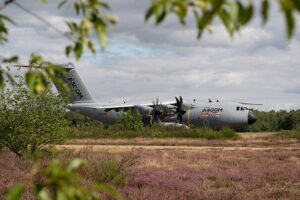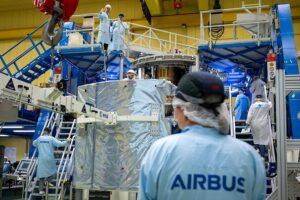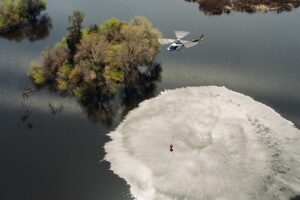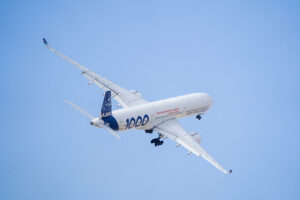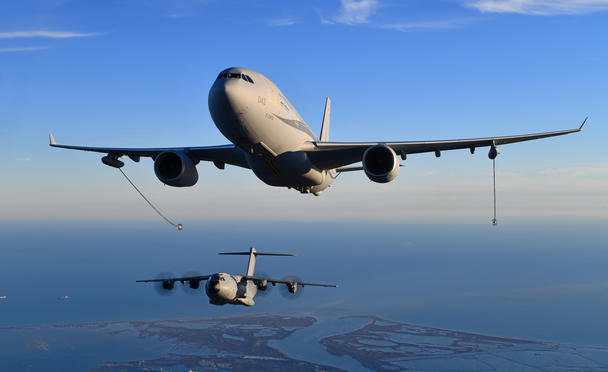
What makes the A330 MRTT so special? The aircraft’s pioneering innovations in air-to-air refuelling, dual use European civil-military technology and the strategic autonomy it gives its operators are at the heart of its worldwide appeal.
It was more than a century ago that two US Air Force DH-4B biplanes carried out the first successful air-to-air refuelling. According to aviation historians, Lieutenant Virgil Hine and Lieutenant Frank W. Seifert in the tanker had to lower a 15-metre hose by hand while flying in formation – an incredibly risky manoeuvre. Meanwhile, Captain Lowell H. Smith and Lieutenant John P. Richter in the receiving aircraft were able to grab the hose and connect it, transferring approximately 284 litres of fuel.
Fast forward from those pioneering flights in 1923 to today.
The hundreds of litres of fuel transferred in those first hose operations have been transformed by a sophisticated boom system into fuel flows of up to 4,500 litres per minute, and 1,500 litres with hose and drogue.Thanks to the Airbus A330 MRTT, a market that was dominated by US manufacturers until the late 2000s is now technologically led by Europe. The tanker aircraft is capable of refuelling 25 different receiver aircraft and providing global coverage for air forces with a range of up to 16,000km.
The aircraft that can reach every corner of the world
Air-to-air refuelling has paved the way for air forces to extend their reach and enhance their strategic capabilities. Today, the A330 MRTT supports critical missions ranging from air power projection, rapid troop deployment and cargo transport to aeromedical evacuation and humanitarian relief.
Standing on the shoulders of giants
“Two aircraft flying at 20,000 or even 30,000 feet at a ground speed of about 800 km/h, approaching each other until they are only about 20 metres apart when the boom or hoses are extended and then physically connected… Air-to-air refuelling is an amazing aerial feat, but we have come a long way technologically,” says Juan Cabrera García, Flight Test Engineer & Test Aerial Refuelling Operator at Airbus Defence and Space.
The development of the A330 MRTT’s boom system, which is operated from a dedicated console located behind the pilot in the cockpit, was a critical aspect of the programme. “At Airbus, we had no experience in air-to-air refuelling with a boom 20 years ago. And since our company’s first experimental air to air refuelling in 2007, we have developed the first 100% electric boom and the first high-definition 3D remote vision system, which also set the benchmark for visual systems,” says Cabrera.
This camera system has recently upgraded to the latest camera-sensor technology for both hose and boom operations, including covert capability for the former. “This allows night refuelling operations to be carried out without any visible external lighting and the operation to be performed by the receiver using night vision googles,” says Cabrera. “This all reduces the MRTT’s detectability.”
“With the A330 MRTT, it is true to say that we are standing on the shoulders of giants. It all started 20 years ago when a group of bold and talented people developed the first in-flight boom refuelling system in the history of Airbus, in what was then a single supplier market. Few could have imagined that the A330 MRTT would go on to become the world’s leading tanker aircraft.” María Ángeles Martí, Head of Tanker and Derivatives at Airbus Defence and Space
The Airbus A330 MRTT can refuel other aircraft using the hose and drogue (shown here refuelling the Eurofighter) or boom refuelling systems, or the fuselage refuelling unit for large probe-equipped aircraft such as the A400M.
Leading innovation with automatic air-to-air refuelling
Cabrera was involved in all the campaigns leading to the development and certification of the world’s first automatic air-to-air refuelling (A3R) using a boom system on the A330 MRTT in 2022. “Air-to-air refuelling with a jet tanker began in the 1960s and has remained more or less the same for decades, with an operator required for all phases of refuelling, with no or minimal automation. With the A330 MRTT, we have managed to automate some of these phases, the most critical and essential ones,” he explains.
Automating a complex operation such as refuelling mitigates risk factors such as operator skill, training, fatigue or stress, or atmospheric turbulence. “The A3R system always performs at the same level and increases safety. It exceeds the performance of the average manual operation,” says Cabrera, adding that Airbus engineering teams are already working on adding automatic capabilities for hose and drogue operations. The ultimate goal is to develop a fully autonomous [A4R] capability, whose concept of operation has already been demonstrated in flight.
In March 2025, Airbus completed the certification tests for the A330 MRTT’s automatic night operation capability. A final campaign to demonstrate the compatibility with the Singapore Air Force’s receivers will take place this Spring, the last stage before certification.
Civil to military: the importance of dual use technologies
Innovation is the lifeblood of progress, and one area where this is evident is in dual-use technologies that seamlessly bridge the civil and military domains. This duality has been a common denominator in the success of the A330 MRTT, which has achieved a market share of over 90% (outside the US).
Ten operators and 15 nations fly the aircraft: Australia, France, NATO’s 6-nation Multinational MRTT Fleet (Germany, Netherlands, Luxemburg, Norway, Belgium, Czech Republic), Saudi Arabia, Singapore, South Korea, the United Arab Emirates, the United Kingdom, Spain and Canada, which already operates an A330-200 that will be converted into a tanker.
“This programme is a shining example of civil aviation ingenuity reimagined for defence,” says Guillaume Duchemin, Head of Military Derivatives at Airbus Commercial Aircraft.
Originally designed as a commercial airliner, the A330 is a twin-engine aircraft that is flown by airlines around the world, with more than 1,800 orders to date.
Following a nine-month conversion process at Airbus’ facilities in Getafe, Spain, involving some 50,000 modifications to the aircraft and 100,000 hours of work, the A330 is transformed into the Multi-Role Transport Aircraft. “The A330 MRTT symbolises the heights the company can reach by maximising the skills of its people and leveraging synergies across its businesses,” says Duchemin.
The next major evolution will be the A330 MRTT+, with the A330-200 baseline aircraft replaced by the A330neo (A330-800). This will allow for aircraft’s fuel burn reduction and more range and/or offload capacity. Furthermore, Airbus is working at enhancing components such as electronic warfare and connectivity.
In the long term the aim is to expand the aircraft’s military roles. The knowledge and learnings from the A330 MRTT conversion process will be valuable for new military derivatives that Airbus is studying, such as the militarised version of the A321XLR for maritime patrol. “Both commercial and defence teams share the same commitment to continue evolving the product. United, we look forward to a bright future,” concludes Guillaume Duchemin.
In February 2025, the French Defence Procurement Agency (Direction Générale de l’Armement) has signed a contract with Airbus Defence and Space as prime contractor, in partnership with Thales, for a risk-assessment study of the future maritime patrol aircraft programme, which would be based on the Airbus A321XLR.

